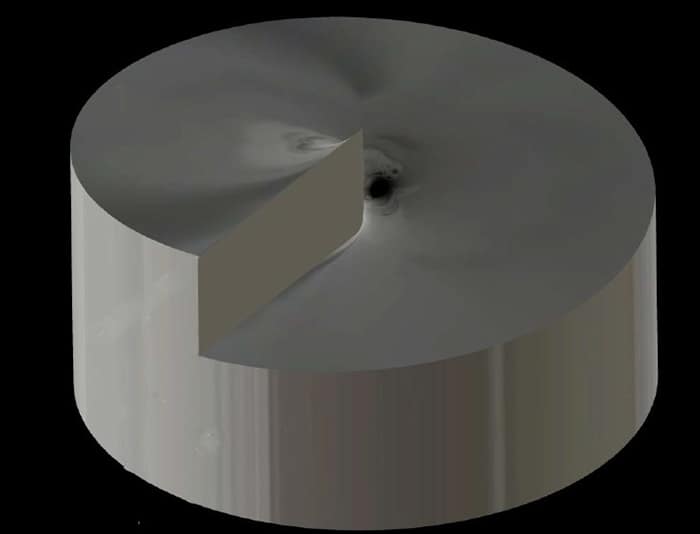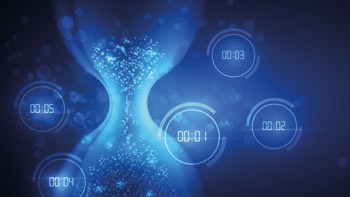
The orbital angular momentum of neutrons has been measured and controlled for the first time by researchers in Canada and the US. The research opens up the possibility of using beams of “twisted” neutrons as a new probe of materials, and could also lead to applications in quantum-information science and new tests of the foundations of quantum mechanics.
The principle of wave–particle duality at the heart of quantum mechanics means that neutrons scattered from a sample will have a wave-like diffraction pattern that can be used to study the structural and magnetic properties of a wide range of materials. Furthermore, neutrons interact very differently with the constituent atoms of materials than do photons or electrons. This means that neutron scattering can often probe material properties that are inaccessible to electron beams or synchrotron light.
All waves can carry orbital angular momentum, which arises from wavefronts being twisted around the wave’s axis of propagation like spirals of fusilli pasta. The orbital angular momentum of both photons and electrons has already proven useful for both investigating and manipulating matter. Photons with orbital angular momentum, for example, have been used to rotate tiny objects. Orbital-angular-momentum-carrying “twisted” electrons, meanwhile, have distinguished between enantiomers of chiral magnets, which could be useful for analysing pharmaceuticals. However, until now, it has not been possible to measure or control the angular momentum of neutrons, partly because it is almost impossible to produce a beam of coherent neutrons in the same rotational state.
Simple device
Now, Dmitry Pushin and colleagues at the University of Waterloo, along with physicists at the Joint Quantum Institute in Maryland and Boston University, have used a remarkably simple device to create beams of twisted neutrons and then measured their orbital angular momentum using a neutron interferometer.
The twisted neutrons are made by passing a low-intensity beam of cold neutrons from a nuclear reactor through a spiral phase plate (SPP) – a coin-sized piece of solid aluminium that resembles one twist of a spiral ramp (see figure “Ramping up”). Neutrons speed up slightly as they pass through aluminium, so the phase of the parts of the neutron wavefront that travels through thinner regions of the SPP is delayed relative to the parts of the wavefront that travel through thicker regions. As a result, the emerging beam has orbital angular momentum. Different phase plates were designed to imprint different amounts of angular momenta on the beam.
The team then measures the angular momentum imparted by the SPPs using a neutron interferometer (see figure “Particle interference”). The neutron beam from the reactor is first split into two beams by the interferometer. One beam is sent though an SPP and the other is not. The beams are then recombined, and the resulting interference pattern can be related to the orbital angular momentum of the beam that passed through the SPP.
One neutron at a time
An important feature of the experiment is that it was done with a very low intensity neutron beam, which means that neutrons went through the experiment one at a time. As a result, each neutron interferes with itself in a coherent manner – eliminating the need for a coherent beam of neutrons in the same rotational state.
Pushin predicts that the twisted neutrons will eventually be used as a tool to study matter: “We have had more time to study the orbital angular momentum of light and electrons, and we can see that the applications are growing and growing.” He adds, “What we have done here is a first step, and we cannot really predict where the applications will be.” Beyond this, the researchers intend to look at quantum entanglement between the various degrees of freedom of the neutrons, and applications to quantum information science.
Neutron optics specialist
Yuji Hasegawa of Vienna Institute of Technology describes the research as “great work” and believes that twisted neutrons may provide useful insights into fundamental quantum physics because “many quantum features are very obvious” with neutrons. However, he is sceptical about the potential of neutrons to provide a practical system for quantum information because of the need for a nuclear reactor as a neutron source.
Twisted-light expert Miles Padgett of the University of Glasgow, meanwhile, is most impressed by the vivid demonstration of wave–particle duality: “This is the most particle-like, extreme form of orbital angular momentum that’s been reported,” he says, “and interestingly, they’ve done it using exactly the same techniques that one would have used optically.”
The research is described in Nature.




